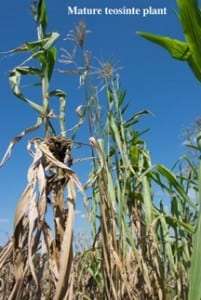
Len Wilcox explores the original GMO food.
Teosinte is a grass native to Central America. It’s also the first GMO food in the Americas, perhaps the world.
The leaves and stalk of Teosinte look like the plant that its descendants would become – it looks like a corn stalk with the typical long, pointed leaves. The seed pod is different, as Teosinte does not grow a cob, and the seed kernels are harder than corn. But the seeds are still useful food, and the stalk is sweet like sugar cane.
For thousands of years, it was a staple of the Mayan diet, and sometime around 6000 BC, the Mayans began cultivating their Teosinte on farms, instead of collecting it in the wild. The Mayan culture grew to be advanced and used sophisticated farming technology, including extensive canals and ditches for irrigation.
As they domesticated Teosinte, the farmers used selective breeding and it became a radically different plant. They’d save the seeds of those that were larger, tastier, or easier to grind. They’d learned to hybridize, and by 4000 BC, Teosinte had become maize, with cobs an inch long.
Maize was the first genetically modified food. Okay, they didn’t slice the genes and put them back together. What they did took many generations to gain the changes they wanted, but it was the same net effect, just stretched out over hundreds of years. Eventually maize became corn.
Corn is not alone in being engineered by our ancestors. Almost everything we grow has been hybridized. Neil deGrasse Tyson said it well: “Practically every food you buy in a store for consumption by humans is genetically modified food. There are no wild, seedless watermelons.”
Since early times, people have systematically improved all of the foods we eat. It’s artificial selection, and everything tastes better, is less expensive, grows more efficiently, or is healthier because of it. Manipulating genes is just an improvement on an ancient technique that we use to feed the world.
I’m Len Wilcox and that’s the Western View from AgNet West.









